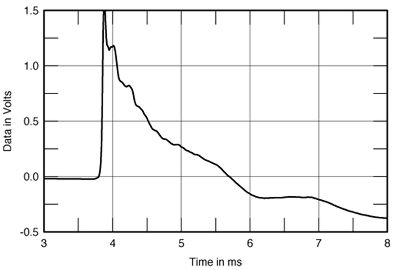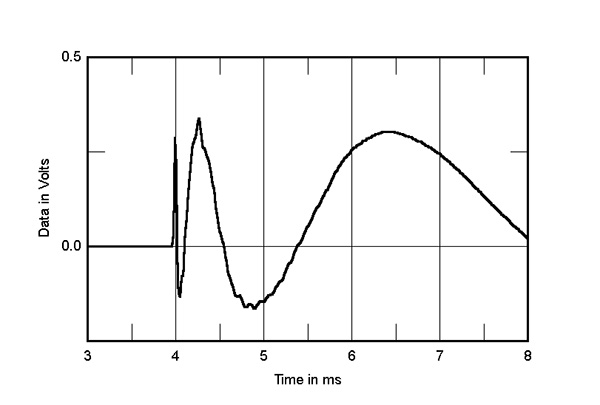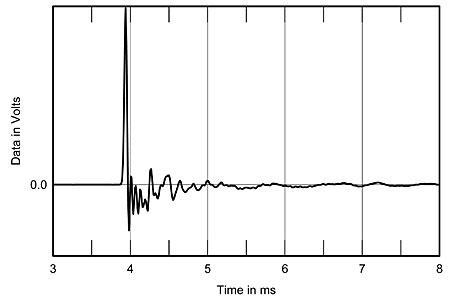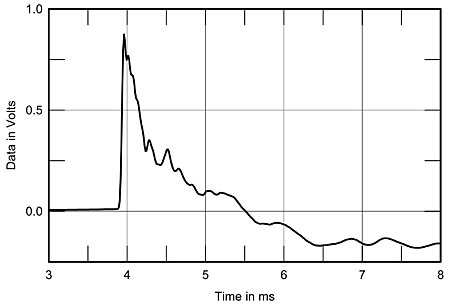Well hope you get to hear them
barefootsound
The Barefoot Sound MicroMain27 is a world-class active studio monitor with vanishingly low distortion, breathtaking dynamic range, and an ultra-fast transient response.
Sounds like my kind of speaker
I lost interest in them after reading the pro reviews at Sweetwater. More of an analytical tool than for musical enjoyment. Ruthlessly revealing, shows everything on the recording, and if you have bad recordings speaker will show that bad sound. Plus I do not need 116dB listening levels. MEME does allow:
But it got me thinking about another pro monitor that made it into the audiophile community Earthworks Sigma 6.2 loudspeaker. I am not a big fan of poly cones but is often necessary in 1st order due to large bandwidth they must cover to avoid the nasty breakups.
Earthworks Sigma 6.2 step response shows an excellent, time-coherent right-triangle shape,
It is very rare, in my experience, to find a loudspeaker that excels in both the frequency and time domains. Taken overall, its measurements suggest that the Earthworks Sigma 6.2 joins that small community.—John Atkinson
As an aside, I prefer nearfield listening for rock, pop, and techno. Possible because these genres are mastered nearfield so it makes sense music will sound best when played back the same way. Audiophile speakers were originally designed for acoustic instruments played and recorded in real space. The dealer continued, if I listen to rock, might as well get some cheap Polks and be done with it. While I agree with the concept of what he said, I do believe rock music can benefit from better speakers. You just need to find the right kind. |
@cdc Well the issue with the micromain isn’t the frequency response which is ideally should be a variation of neutral which it is on axis. And also because you’d be nearfield, flat on axis is what you want but you also want a pretty controlled and wide enough dispersion. The Micromain is too tight with the dispersion pattern control. You not needing 116dB levels is something you can control using a volume dial so I don’t get your comment regarding that. You’re the one that will push it to that peak level if you run the input gain near maximum so that isn’t really a factor
Also it being revealing is something I thought audiophiles want. Listening to the actual mix in its truth (but as I’ve grown I’ve noticed that is the opposite of what most of y’all want) Most people want to add their own twist to what the song is. Sometimes a song is mixed and mastered terribly because of what monitors were used and u til you k ow theonitors used and buy them to listen to said album I’d say it is better to get the neutral speaker that can play both the great mixes and bad mixes as they’re. Time domain is not really an issue unless your speakers are like over 10ms.
Also looking at the two time domains. Actually the Mon time aligned one is actually better for transients. For the normal time domain, non-time aligned graph there is: Sharp initial peak around 3.9 ms reaching approximately 0.6 Volts. * Relatively rapid decay of oscillations after the initial peak. The ringing settles close to zero within about 1.5-2 ms after the initial impulse. * The oscillations are relatively small in amplitude compared to the initial peak. For the second time aligned Image 2 (Second Response): * Sharp initial peak around 3.9 ms reaching approximately 1.5 Volts (significantly higher amplitude than the first). * Significantly slower decay of the response after the initial peak. The signal takes much longer to settle back to zero, exhibiting more sustained oscillations. * The oscillations are also larger in amplitude and more complex compared to the first response. There are distinct secondary peaks and a more prolonged "tail" to the response.
Based on these time-domain responses alone, the first response (from your initial image) is generally considered better for speaker performance. It exhibits a faster decay of oscillations and less ringing after the initial impulse, which typically translates to better transient response, improved clarity, and a less "colored" sound.
Basically I’d say don’t be smitten by time aligned drivers like that cos that means longer tails fo reverb from the speaker alone and combine that with your room then that compounds the issue.
I’d recommend the Genelec 8361A rather.
Get a pair from Thomas. They have the best prices.
In White - Singular 8361A in White
Or
In Anthracite - Singular 8361 in Anthracite |
Sounds like you have a background in studio monitors. What do you think about nearfield vs. farfield listening for rock and techno. Would it sound more "right" because it is mastered nearfield? Most people here listen to jazz, quartet, classical, and orchestra so it makes sense they want farfield speakers to recreate the soundfield of those types of music and instruments. Would there be a speaker better at electric guitar, synthesizer, drums than one for acoustic instruments? I agree about flat FR. It bothers me some 5 figure audiophile speakers can’t even get the basic’s like flat FR right.
So you have heard them and this is a design flaw?
My thought is if the speaker is designed to play a 116dB will it cause a shortcoming somewhere else? Why pay for performance that has no use?
The longer I listen the more I move away from "ruthlessly revealing" ( fatiguing) sound. When a speaker makes the focus of a song the recording defects and quality of musicianship IME it looses it’s musicality. When I start liking the song, not for the tune but because it is well recorded or the musicians are talented something has gone wrong, YMMV. There are other things than raw detail retrieval that aren’t relevant to mastering. Things like PRAT, colors, bloom. Why do I not care for ATC? They play loud with no compression. They are clear, accurate, and not fatiguing. Maybe because they are so rigid they loose the musicality. Like compare Benchmark to NOS DAC and sound goes from etched, bleached out white to colors, but not coloration. If that makes any sense.
Really? What do you think about typical step response shown below? Sure each driver blends with the next but do you think they time well and pick up on the PRAT if it’s in the song? You think you can’t hear the difference between the Earthworks Sigma 6.2 and TAD CE1TX? I do not know. I am just asking.
Not following you. I only posted one. What does the Mon look like?
That is an interesting point.
Thanks for the recommendation about Genelec. I was looking forward to hearing the Genelec’s G Three powered loudspeaker after Stereophile gave them an "A". They sounded so bad in the store I did not think they could be saved by better setup or electronics.
|
You got me thinking about single driver vs. time aligned multi driver. What do you think about Fujitsu Ten Eclipse TD712z loudspeaker A single 4.7" driver with a glass-fiber cone is mounted in an egg-shaped enclosure of artificial marble,
Which would you choose? What is the ideal number of drivers in a loudspeaker system? You have your answer? Good. Next question: What is the best type of crossover in a loudspeaker system?
Eclipse TD712z, impulse response on drive-unit axis at 50" (5ms time window, 30kHz bandwidth).
and Eclipse TD712z, step response on drive-unit axis at 50" (5ms time window, 30kHz bandwidth).
|
I am a hobbyist producer yes with friends who are actual mixing and mastering engineers, so I know a decent bit. A nearfield speaker can be good for farfield provided the dispersion is controlled, is wide enough and can provide the necessary SPL at the longer distances. Unless you have the specific speaker used n the studio at the time of mixing and mastering said guitar record, it is better to get a speaker that allows the quality of the record to shine and the Micromain does that but is narrow with dispersion vertically so I'd rather you get the Genelec with the class leading dispersion control that can also do both near and farfield |
No. Not needing to play that loud sustained means there is ample headroom for when you play music that has a lot of big transient swings. You're using the speaker's performance and ease of use SPL wise. you don't want a speaker that can only do 100dB peak. remember this metric is mostly determined at 1kHz and bass frequencies need to be 10 to 20dB louder to be perceptively heard so yeah that headroom is very important |
I do not subscribe to the notion of Benchmark being etched... they do not add anything to the frequency response in your room. Moving the speakers a mm does more to the sound than any DAC ever would and especially not a pretty top of the line neutral DAC that doesn't add anything and allows a song to shine as is. Maybe I have a different experience |
Single drivers imo are a gimmicky mess with their over compression that happens are the breakup mode. they narrow up too early and become pinpoint directional for treble so very tapering and thus in room will sound dark and bright at the same time. haven't heard that YG speaker but the ones I've heard have been pretty good sounding with good honesty and delivery of tonal balance.
Ideal number od driver depends on what implementation you wanna do. Provided the drivers are chosen meticulously with parameters that makes marrying one to another easy, I'd say a 3 way is pretty much a great balance across board. Can help with sensitivity. But you gotta be good with your crossover slopes to mitigate transducer limits. first orders are not ideal imo. 2nd, 3rd and 4th have their uses depending on the drivers you're using and what kind of balance and control you wanna achieve |
I've heard great speakers across almost all driver implementations except single drivers so that surely should be what to avoid @cdc |





